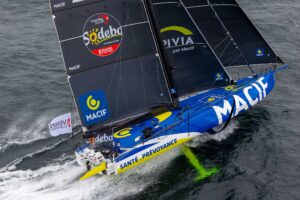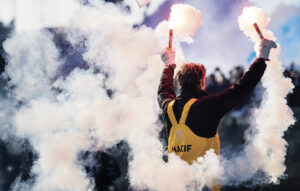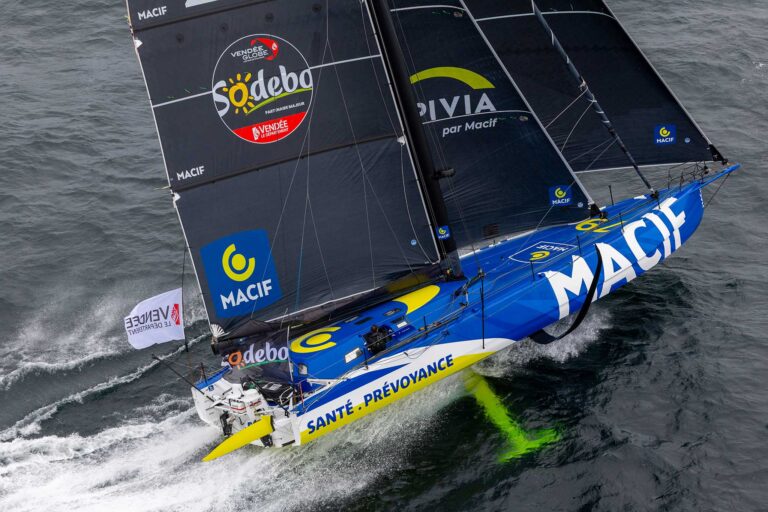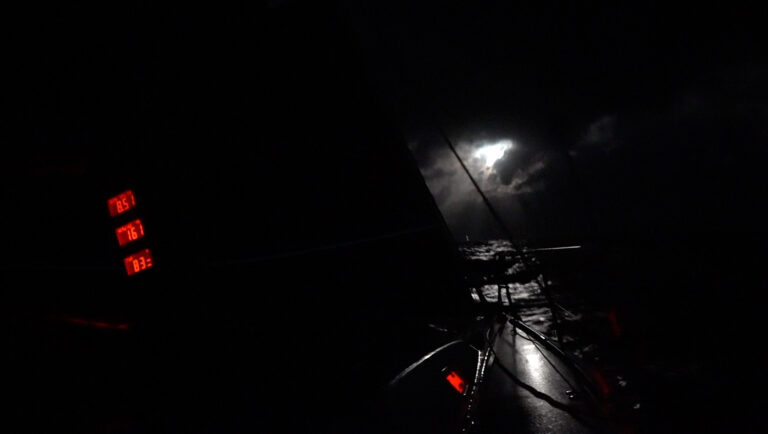
Bermuda’s 75-degree water makes sailing foiling catamarans pretty fantastic. Let’s be frank, San Francisco is a cold place to sail. And the fact that you’re on a boat being hosed with spray and 50 knots of apparent wind as normal operating conditions doesn’t make things any easier. Dry suits were common, wetsuits were a must. While advances in control systems and foil design have made the modern 50ft America’s Cup Class catamarans capable of sailing “dry” laps, the unavoidable splash still makes for a generally wet ride for the six-man crews. That said, for the four grinders on board, as soon as we start our day we’re warmed up, and a good bit of spray is a welcome relief from the balmy Bermuda southwesterlies.
Once we’re off the dock and have gone jib-up, we slowly make our way through Dundonald Channel onto Bermuda’s Great Sound. “Slowly” means closehauled and flying a hull at about 13 knots. As soon as we’re clear of the reef and happy with our systems checks, it’s as simple as putting the bow down and building to takeoff speed. In 12 knots of wind, this is not much of a press, although loads do increase as the boat strains, dragging both rudders, their elevators and the L-shaped leeward daggerboard through the water, along with 50ft of leeward hull.

By now the grinders will have already started pumping pressure behind the hydraulic lines to prep for the upcoming maneuvers and trim adjustments. So as soon as takeoff speed is achieved our helmsman, Jimmy Spithill, simply makes a quick pitch adjustment to the leeward daggerboard, activating a set of hydraulic cylinders to push the head of the daggerboard aft, thereby changing the angle of attack of the horizontal portion of the foil. Once the angle is high enough and the lift it creates exceeds the weight of the boat, there is a short jolt as the leeward hull breaks the surface of the water and the boat releases into full-foiling mode.
As it does so, a quiet comes over the boat, and there is no longer any spray washing over the leeward bow as the boatspeed quickly doubles. While it’s true the effort the sailors are putting into the pedestals combined with the communications and 50 knots of apparent wind make for a noisy environment overall. The boat’s actual movement is quite dampened because we’re now riding above the sea state. Gone is the pitching, slamming and hacking into the chop of traditional sailing.

That said, there is little margin of error. The entire time the boat is airborne, Jimmy’s steering, the angle of attack of the foil, and the angle of the wingsail and its twist all contribute to keeping the boat aloft. These elements, in turn, are all controlled using hydraulic pressure created by the wattage put into the grinding pedestals. As a practical matter, every adjustment creates energy demand, and conservation is paramount to having enough energy in the tank for maneuvering over the entire racecourse. At the same time, any misstep in helm, foil or wing trim can send the boat careening back down into the water. Thirty knots back to 10 knots makes for some significant g-force, and the urgency of getting the boat back on the rails is obvious. In the end trying to keep calm and continue to do your job at 90 percent, maximum heart rate is one of the biggest challenges of sailing an ACC cat.
For more on what it’s like sailing and racing a full-foiling ACC catamaran, including video and insights into AC35 strategy and tactics, visit sailmagazine.com/racing/americas-cup









